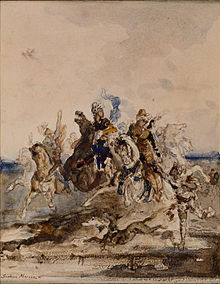Horses in Iran
 Darius's horse neighs in the sunlight. This drawing by Gustave Moreau depicts a famous Persian hippomancy scene. | |
| Use | Show jumping |
|---|---|
The history of horses in Iran goes back to Greek sources from ancient Persia, which mention horse worship and the practice of hippomancy. Today, Iranians breed several breeds of horse, most of them Arabian,[1] in particular the Koheilan and Saklawi lines.
History[edit]
Horses played an important cultural role in ancient Persia.[2] Herodotus and Ctesias attest to the practice of hippomancy (divination by horse), which continued into the Sasanian era.[3] According to Herodotus' Histories, the Nisean horse was considered sacred in the 5th century BC.[4]
Darius exploited this Persian belief in hippomancy to ensure his royal legitimacy.[5] It is possible that Darius used this ruse or propagated the story to appease his people, who strongly believed in hippomancy.[6]

Georges Dumézil sees it as a possible Indo-European rite of enthronement.[7] Persian military horsemen may also have been diviners.[8]
In 1965, an American, Louise Firouz, rediscovered the Caspian horse in the Elbourz mountains, on the shores of the Caspian Sea.[9] In the 1970s, the Royal Iranian Horse Society proposed the name "Persian plateau horse" to designate a group of fairly heterogeneous horses bred in the tribal areas of the Iranian plateau with various Indo-European influences.[10]
Breeding[edit]
The DAD-IS database lists 21 breeds of horse currently or formerly bred in the Islamic Republic of Iran: Bakhtiari, Basseri, Caspian, Dareshuri, Ebian, Haddian, Hamdani, Iranian Arabian horse, Jaf, Kahilan, Kurdish horse, Persian Arabian, Qarabagh, Qashqai, Saklawi, Shirazi, Sistani, Taleshi, Taropud, Turkemin and Yabu.[11]
The CAB International study (2016) distinguishes three main types or breeds of horse in Iran: the Persian Arabian, the Persian Plateau horse and the Turkoman, divided into numerous subtypes, whose characterizations remain unclear.[10] It also mentions the existence of the Tchenaran horse.[10]
References[edit]
- ^ Hendricks (2007, p. 337)
- ^ Llewellyn-Jones, Lloyd (2013). King and Court in Ancient Persia 559 to 331 BCE. Oxford University Press. p. 272. ISBN 978-0-7486-7711-5.
- ^ Ferlampin-Acher, Christine (2002). Fées, bestes et luitons : croyances et merveilles dans les romans français en prose (xiiie – xive siècles) (in French). Presses Paris Sorbonne. p. 513. ISBN 978-2-84050-193-0.
- ^ "Histoires" (in French).
- ^ "Hérodote, Histoires" (in French).
- ^ Wagner, Marc-André (2005). Le cheval dans les croyances germaniques : paganisme, christianisme et traditions (in French). Nouvelle bibliothèque du moyen âge. p. 974. ISBN 978-2-7453-1216-7.
- ^ Dumézil, Georges (1985). "Hérodote et l'intronisation de Darius". L'oubli de l'Homme et l'honneur des Dieux (in French). pp. 246–253.
- ^ Fagan, Garrett; Trundle, Matthew (2010). New Perspectives on Ancient Warfare. BRILL. p. 372. ISBN 978-90-04-18598-2.
- ^ Hendricks (2007, p. 112)
- ^ a b c Porter et al. (2016, p. 495)
- ^ "Breeds from species:Horse". DAD-IS. Retrieved 21 November 2016.
Bibliography[edit]
- Hendricks, Bonnie (2007). International Encyclopedia of Horse Breeds (2nd ed.). Norman: University of Oklahoma Press. ISBN 978-0-8061-3884-8.
- Porter, Valerie; Alderson, Lawrence; Hall, Stephen; Sponenberg, Dan (2016). Mason's World Encyclopedia of Livestock Breeds and Breeding (6th ed.). CAB International. ISBN 978-1-84593-466-8.


 French
French Deutsch
Deutsch